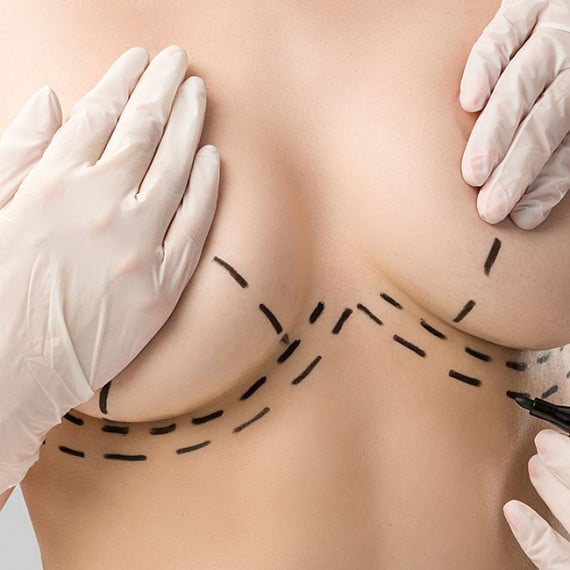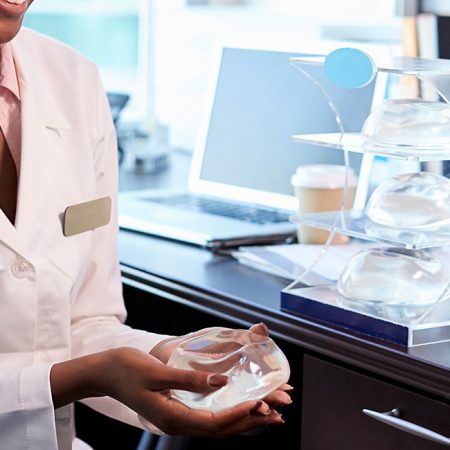Capsular contracture is a breast augmentation complication which occurs when a naturally forming layer of scar tissue grows excessively around a breast implant, thereby contracting it and giving the breast a hard look and feel. A scar forms around the implant outlining it and the condition has the potential to be fairly painful. Capsular contractures are found to be less common with saline implants than with old style silicone implants, the newer ones appear better.
Capsular contracture with breast implants is a problem suffered by patients who have had breast augmentation surgery. This complication has bewildered many plastic surgeons as well as their patients. It is not pleasant for either party.
A capsular contracture complication is when the normal healing process of the breast augmentation which normally forms a flexible and thin shield around the implant becomes excessive. This thickening of the typical tissue found around the implant can make the breast feel hard, and even cause back pains. Plastic surgeons classify this according to grading system named after Dr. Baker.
What are the levels of Capsular Contracture?
There are varying levels of capsular contracture that occur with breast augmentation patients. These levels if diagnosed correctly can help determine the correct course of action to take to ensure that you don’t have any further problems and that your breast augmentation has a succesful outcome.
Capsular Contracture Grading System
- Grade I: is when the breast looks natural and is soft to touch.
- Grade II: the breast looks normal but is a little firm to touch.
- Grade III: is characterized by the abnormal look of the breast and it is firm to touch.
- Grade IV: the breast looks abnormal and is hard and painful.
In a mild case or Grade I of capsular contracture it is quite possible for the woman to not realize her condition. A more severe case would require surgery to correct the problem. Dr. Pasquale has treated many breast implant capsular contractures and the results are very good in most cases. In our Hawaii clinic for plastic surgery we have several specialized treatments for breast augmentation patients who have severe contractures or other breast augmentation complications.
Why does Capsular Contracture occur?
Capsular contracture is a natural reaction of the tissue growing over a foreign object in the body. There really is no way of predicting if it will occur again or not. It may be due to an injury, blood around the implant or due to bacteria on the implant, in extremely rare cases. All implants have a capsule form around them, its only when it becomes excessive that is a problem.
Can Capsular Contracture occur again?
There is no way to ensure that capsular contracture doesn’t reoccur as it is caused by the natural growth of tissue on the implant. Our Hawaii plastic surgery clinic has developed specialized protocols to do the best we can to prevent reoccurrence of the capsular contracture. We minimize bleeding and sometimes placed drains. We place the patient on several medications and make sure there is no bacterial contamination. We also believe ultrasonic massage helps prevent or minimize the capsular contracture in our breast augmentation patients.
Reducing Risk of Capsular Contracture
- A lesser chance of capsular contracture is reported when the implant is placed under the muscle. This also allows a more natural look for the breast as there is more breast tissue over the implant.
- While smooth implants are preferred for their natural look and for less wrinkling there are some who believe that textured implants are associated with less case of capsular contracture. We don’t particularly believe that we think the capsular contracture is there but not as noticeable.
- We firmly believe that a collection of blood around the implant stimulates scar tissue formation in breast augmentation and thus one will see complications from this. We do all we can to prevent post operative bleeding and this includes special instruction we provide our patients and excellent pre-operative preparation.
- Our meticulous techniques we believe help to prevent this breast augmentation complication and our experienced Hawaii staff undergoes training every Wednesday in our Honolulu clinic.
- One of the techniques we use here at our clinic to prevent and to actually treat capsular contracture is the ultrasound which we believe has been very effective.
It is vital that breast augmentation be performed by a certified plastic surgeon that is qualified and experienced. Dr. Michael Pasquale is one of the few cosmetic surgeons who has completed his full residency in plastic surgery and also acquired a 2-year training certificate specifically in cosmetic surgery from New York University Downtown Hospital, where he worked under some of New York’s leading plastic and cosmetic surgeons. In his Honolulu Hawaii clinic it is ensured that patients receive all information regarding breast augmentation including its risks and complications.
The Leading Complication for Breast Augmentation
Capsular contracture is the most common problem or complication afflicting breast augmentation patients. It occurs in approximately 5% of breast augmentation patients. Although the capsule is a fully natural occurrence within the body, it can cause the breast to become hard and produce visible distortion of the breast.
A capsule occurs with virtually every foreign object that is placed inside the body. It is a scar-like shell of collagen fibers that encases the object and under normal circumstances is completely harmless. In some cases the capsule grows very thick and tightens around the breast implant causing the breast to feel very dense and possibly painful and appears misshapen. It is still unknown to science why a capsule becomes so severe that it grows to this extent. There are theories based on statistics as to why capsular contracture occurs. Possible factors that may increase the chance of capsular contracture.
Possible Causes of Capsular Contracture
- Infections during or after surgery (dental work)
- Implant rupture (gel or silicone)
- Subglandular breast implant placement
- Radiation (before or after breast augmentation surgery)
- Introduction of bacteria to the implant during or after surgery
- Hematoma or seroma
- Autoimmune disease
Capsulectomy Surgery to Repair Capsular Contracture
Surgery is the last result and in Dr. Pasquale’s practice he has resolved the issue at times times when the thickened scar tissue is removed surgically. There may be no other choice. Even so a very small minority reoccur.
How is a Capsulectomy Surgery Done?
A capsulectomy can be done under local anesthesic, but most patients opt to have it done under general anesthesia. This is decided on by the patient with consultation by the surgeon. The breast is opened back up through the previous or original incision in order to access the breast pocket. After the breast pocket is accessed, the capsule is removed from around the implant. Depending on the severity of the capsule, the implant may be removed during surfery to enable the capsule to be removed more easily. After removal of the capsule, the breasts are inspected for correct implant placement, symmetry and the incisions are closed. The capsulectomy should under normal circumstances result in a soft, natural feeling breast that isn’t misshapen or deformed by the capsule.
Non Surgical Approach to Capsular Contracture
So Dr. Pasquale has tried to develop over the last 25 years a technique and protocol which deals as effectively as possible with this problem in a non-surgical way. First and foremost is prevention. That means such things as being meticulous with surgical technique and making sure that there is no post operative stimulation of capsule formation such as bleeding. If it does occur it must be dealt with and the blood removed from the surgically created area where the implant was placed.
Early Diagnosis of Capsular Contracture
The first step is early detection of a breast which may become firmer as healing takes place. This is essential to try and arrest the development of a grade 2 or 3 contracture. This is done by teaching our patients what to look for and we see them regularly for examination in the early stages of healing.
Ultrasound & Medication
The second step if indeed it appears that the patient is starting to develop this complication we recommend that they take medication or continue with what we have started for a longer period of time. At the same time we recommend gentle ultrasound treatments which are sound waves to reduce the inflammatory process.
Breast Massage & Exercises
Depending on what our examination shows we may advise more aggressive massage or less aggressive or no massage. This will depend on many factors such as how long after surgery it occurs, what we think the reason for the complication and the like.This is individualized.
Steroid Injections
Injection with a steroid to the surrounding scar tissue may be tried and has worked in some cases, but this must be done only in selected patients and with great care as not to puncture the implant or cause tissue atrophy. It is also not widely accepted among all surgeons. Unless they have had experience with this technique which most plastic surgeons have not, we do not advise it for every patient. Dr. Pasquale has done this on selected patients on and off for many years and has had good result. Dr. Flowers and other plastic surgeons taught him this technique many years ago and despite the criticism, it does work according to Dr. Pasquale, the problem is many surgeons do not know how to use this approach. Many times surgeons and patients confuse this with placing steroids during the initial surgery which has NOT been shown to work by scientific research.
Stem cell injection with or without fat transfer around the capsule. This is an experimental technique which has not been studied to make a determination as to the benefits. As this is studied it may prove promising but as of this writing there is no evidence either way. Suzanne summers had a similar procedure done and that article is here
The alternate techniques available for non surgical treatment of capsular contracture are limited, but you may wish to try before undergoing another surgery. What ever technique is used as with all of medicine first do no harm.






